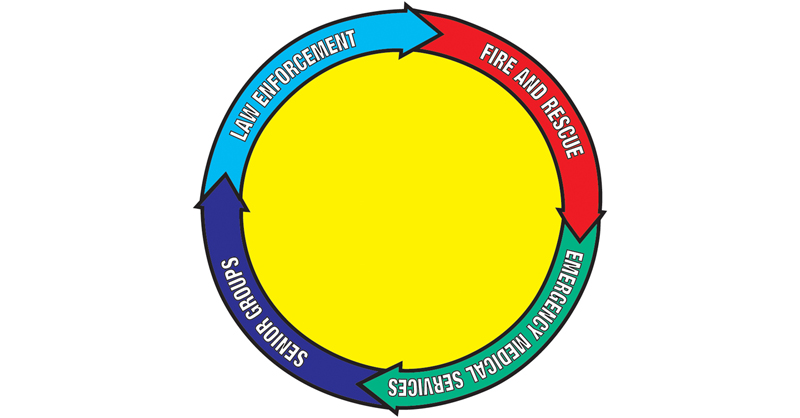T here is a national program in the United States which is sponsored and funded by the Department of Transportation of the United States in which yellow dots are provided free of charge by the transportation departments of several states to place on the rear window of the car of a person who may need medical attention to communicate to and direct first responders — such as members of law enforcement, the fire department, medical professionals or other emergency services personnel — to the glove compartment.
Inside of that glove compartment should be a folder, container, or envelope which contains vital information — such as medical conditions and prescriptions; along with a photograph of the person for quick identification.
Yellow and Purple are Important Colors to Communicate Vital Information During Emergencies
That yellow dot is a sticker which instantly identifies an occupant of a vehicle who may require special attention during a time of need — such as an emergency — and provides critical medical information which can help save a life within precious seconds.
“Illinois launched the program in 2011”, according to this article written by Mark C. Palmer of Travelblawg. “Participants place a circular yellow sticker on the lower left corner of the driver’s side rear window of their vehicles and fill out a card to place in their glove box. On the card is vital personal information that assists first responders in providing the best care for victims in the event of a crash. The information provided on the cards also helps hospital staff make critical decisions in determining the types of medications and treatment to administer.”
Actually, that information conflicts with this article written in 2011 by Larry Copeland of USA TODAY, which states that “The nation’s first Yellow Dot program began in Connecticut in 2002.”
What really matters is the efficacy of the program — and it is gaining ground in more states, such as:
The information on the card includes:
- The name of the participant
- A photograph
- Medical conditions
- Recent surgeries
- Current medications
- Allergies
- Physician information
- Emergency contact information
A Similar Program For People Who Travel?
While there is no specific equivalent program to the yellow dot program for people who travel, Kelli Thomas-Drake is an enterprising woman who founded MyPurpleFolder, which “bridges the gap of communication with both physicians and healthcare systems by empowering patients with their own information” in order to simplify the access of medical information for patients, family caregivers and friends, physicians and healthcare systems.
Although the information at the actual Internet web site is rather sparse at this time, it was the signing of an order not to resuscitate her grandmother which led to the idea of MyPurpleFolder, according to this article written by Kim Lachance Shandrow of Fox News. “When her mother battled breast cancer, the Dallas entrepreneur struggled to help the retired psychiatrist keep track of her essential medical data. Somewhere buried within the messy, discombobulated trail of her mom’s health records were the very keys to the critical information needed to make the most informed care decisions possible.”
While MyPurpleFolder is not a free program sponsored by a government — rather, it seems to be a business for profit where a patient does not have to constantly fill out forms every time he or she sees a medical professional — it seems to be the closest to something which a traveler who needs quick access to their vital medical records just in case something unexpected happens.
Summary
The Yellow Dot program is a great idea about which I had not heard until I originally read the aforementioned article written by Mark C. Palmer; and I immediately wondered if there was an equivalent program for travelers — especially ones who suffer from severe allergies such as Theo Dana, whose family was asked to leave the aircraft one week ago due to a severe allergy to peanuts.
I am also not certain as to what extent MyPurpleFolder is valid in terms of location. Is it only available in the United States?
Perhaps the time has arrived to consider creating a program similar to the Yellow Dot program; but for international travelers. Potential impediments include different medical policies and procedures in different countries and language barriers; but perhaps a program such as this could be vital in the event of an emergency anywhere in the world.
A cursory search on the Internet did not reveal whether or not some sort of program already exists. Do you know of one; and if one does not exist yet, do you believe that it is a potentially good idea?

